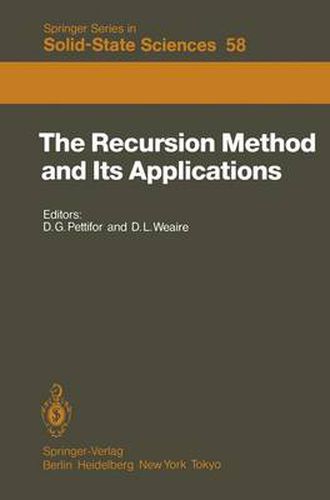Readings Newsletter
Become a Readings Member to make your shopping experience even easier.
Sign in or sign up for free!
You’re not far away from qualifying for FREE standard shipping within Australia
You’ve qualified for FREE standard shipping within Australia
The cart is loading…






This title is printed to order. This book may have been self-published. If so, we cannot guarantee the quality of the content. In the main most books will have gone through the editing process however some may not. We therefore suggest that you be aware of this before ordering this book. If in doubt check either the author or publisher’s details as we are unable to accept any returns unless they are faulty. Please contact us if you have any questions.
This volume reviews recent advances in the development and application of the recursion method in computational solid state physics and elsewhere. It comprises the invited papers which were presented at a two-day conference at Imperial College, London during September 1984. The recursion method is based on the Lanczos algorithm for the tridiago nalisation of matrices, but it is much more than a straightforward numerical technique. It is widely regarded as the most elegant framework for a variety of calculations into which one may incorporate physical insights and a num ber of technical devices. The standard reference is Volume 35 of Solid State Physics, which contains all the early ideas of Heine, Haydock and others, upon which the method was established. The present volume provides the first review of subsequent developments. It also indicates where problems remain, or opinions differ, in the interpretation of the mathematical details or choice of practical techniques in applications. The field is still very li vely and much remains to be done, as the summary chapter clearly demonstra tes. We are grateful to the S. E. R. C. ‘s Collaborative Computational Project No. 9 on the electronic structure of solids and the Institute of Physics’s Solid State Sub-committee for their sponsorship of the conference. We thank Angus MacKinnon for his help in conference organisation and Jacyntha Crawley for secretarial assistance. December 1984 David G. Pettifor Denis L. Weaire v Contents Part I Introduction Why Recur? By V.
$9.00 standard shipping within Australia
FREE standard shipping within Australia for orders over $100.00
Express & International shipping calculated at checkout
This title is printed to order. This book may have been self-published. If so, we cannot guarantee the quality of the content. In the main most books will have gone through the editing process however some may not. We therefore suggest that you be aware of this before ordering this book. If in doubt check either the author or publisher’s details as we are unable to accept any returns unless they are faulty. Please contact us if you have any questions.
This volume reviews recent advances in the development and application of the recursion method in computational solid state physics and elsewhere. It comprises the invited papers which were presented at a two-day conference at Imperial College, London during September 1984. The recursion method is based on the Lanczos algorithm for the tridiago nalisation of matrices, but it is much more than a straightforward numerical technique. It is widely regarded as the most elegant framework for a variety of calculations into which one may incorporate physical insights and a num ber of technical devices. The standard reference is Volume 35 of Solid State Physics, which contains all the early ideas of Heine, Haydock and others, upon which the method was established. The present volume provides the first review of subsequent developments. It also indicates where problems remain, or opinions differ, in the interpretation of the mathematical details or choice of practical techniques in applications. The field is still very li vely and much remains to be done, as the summary chapter clearly demonstra tes. We are grateful to the S. E. R. C. ‘s Collaborative Computational Project No. 9 on the electronic structure of solids and the Institute of Physics’s Solid State Sub-committee for their sponsorship of the conference. We thank Angus MacKinnon for his help in conference organisation and Jacyntha Crawley for secretarial assistance. December 1984 David G. Pettifor Denis L. Weaire v Contents Part I Introduction Why Recur? By V.